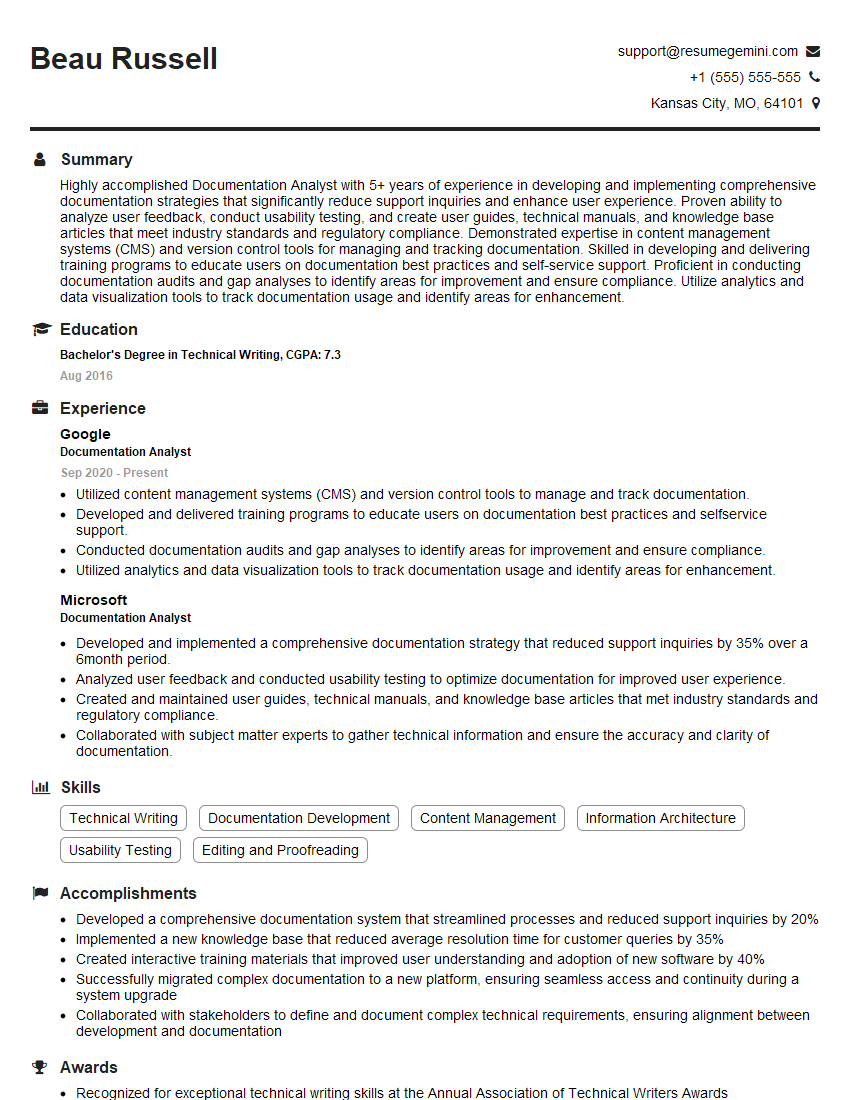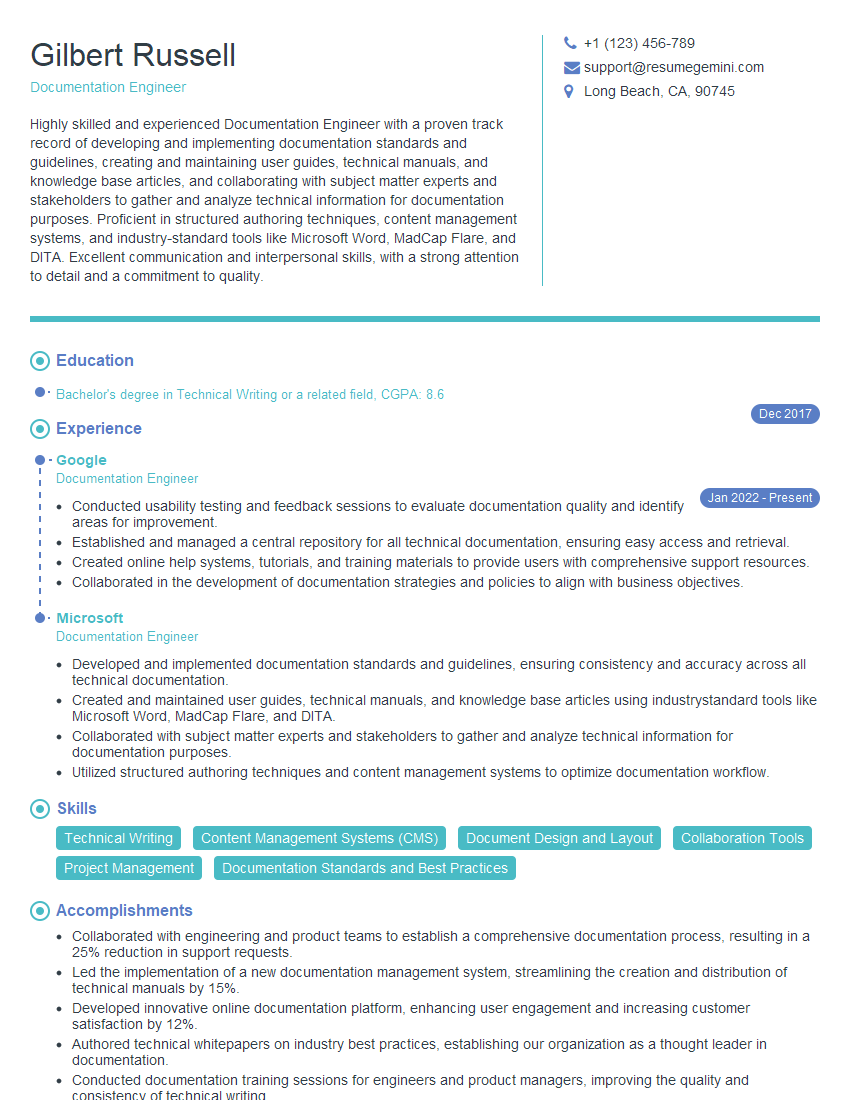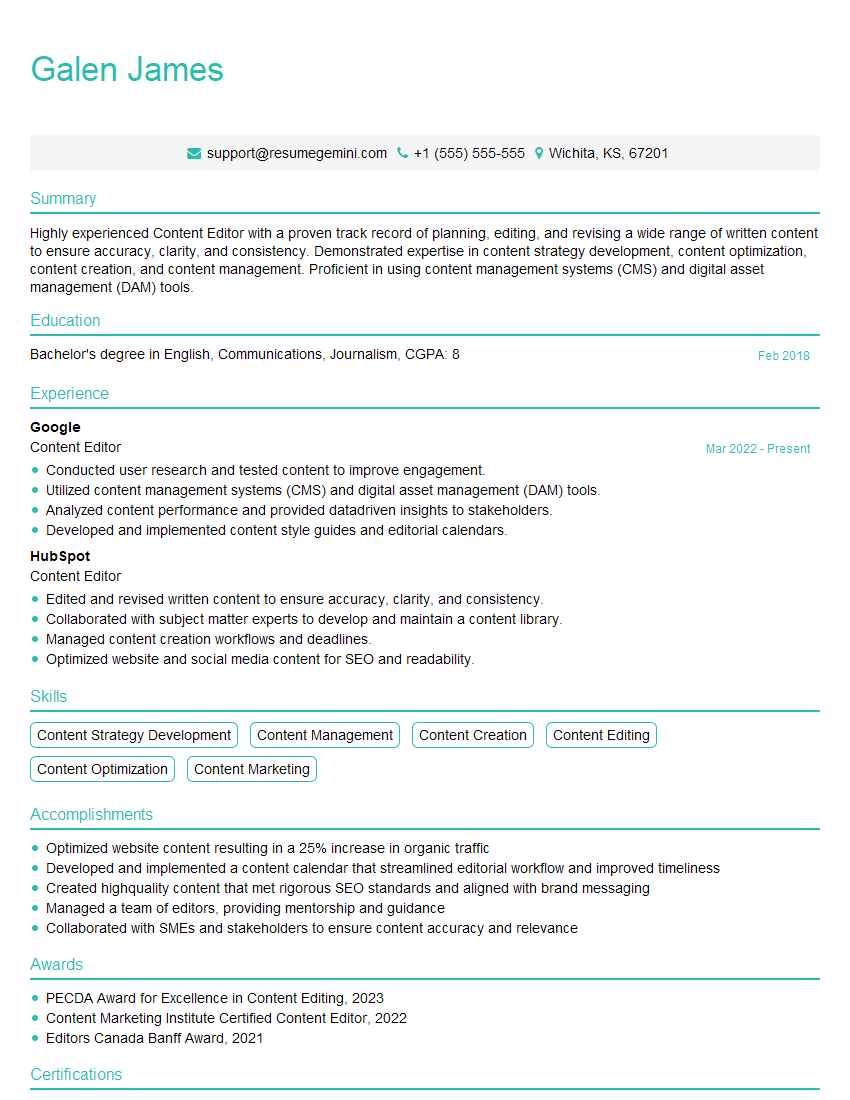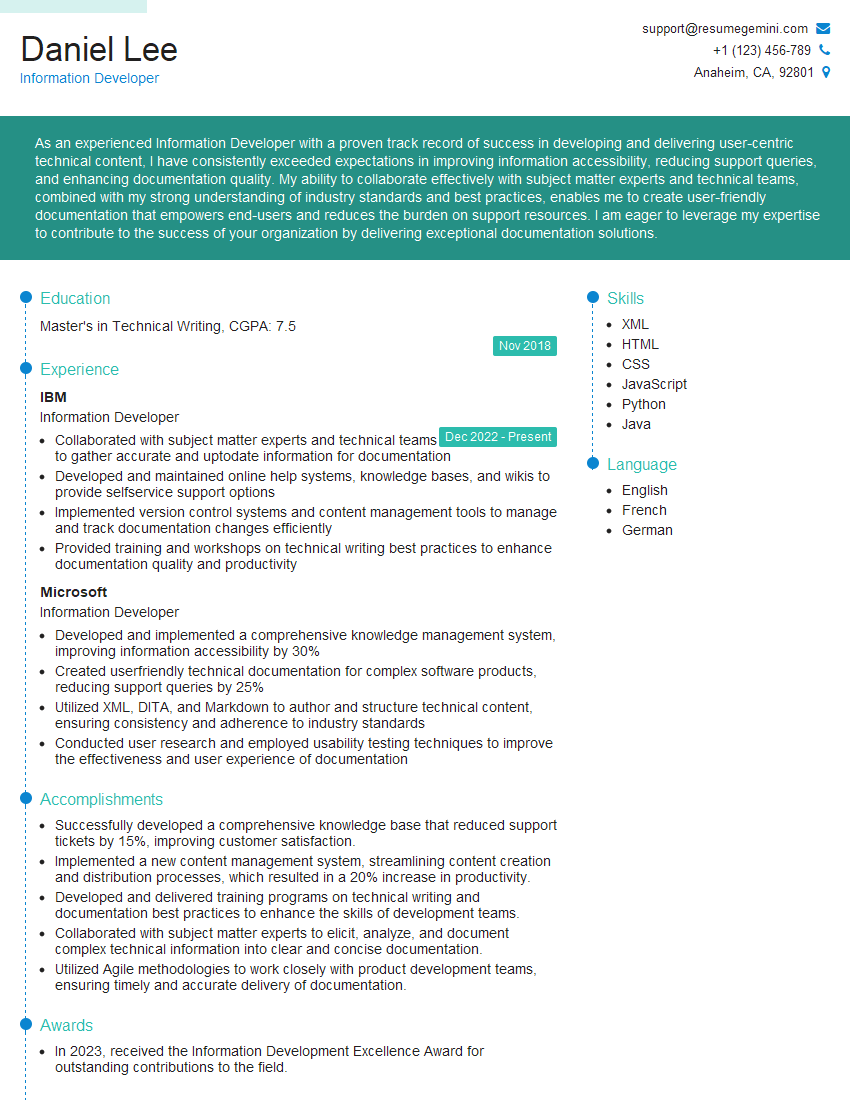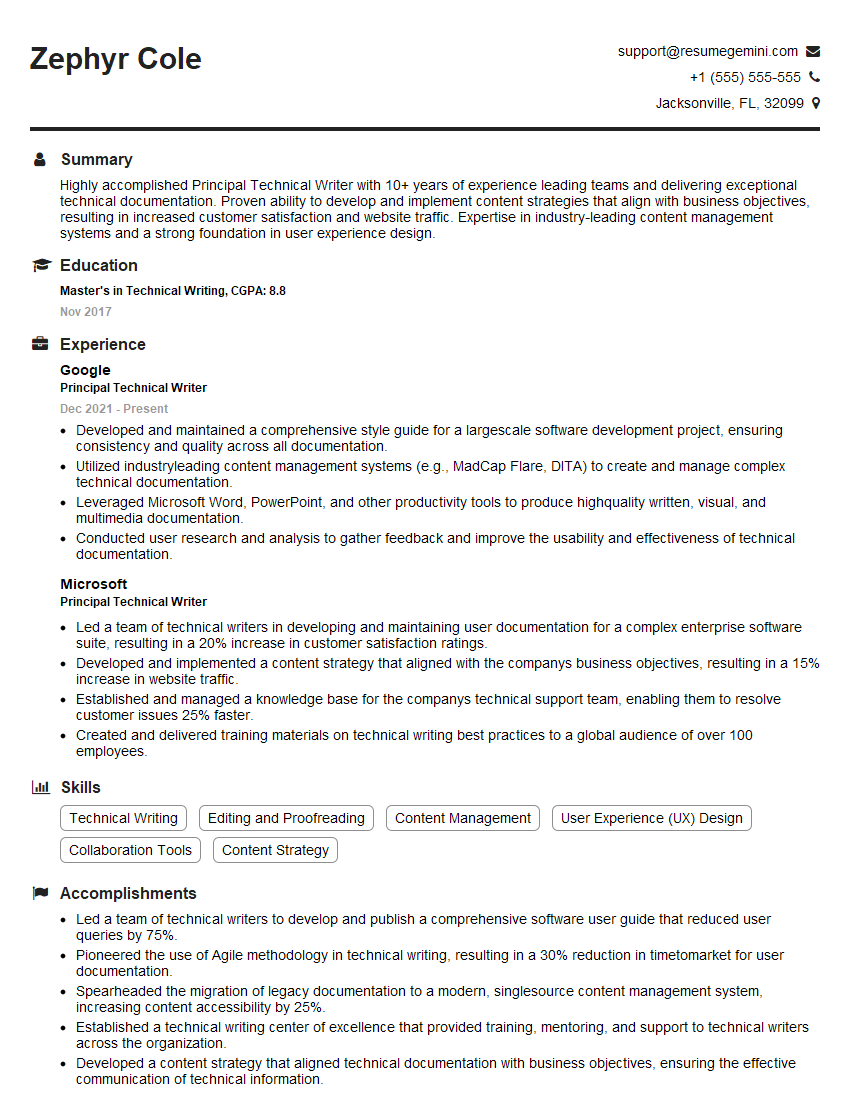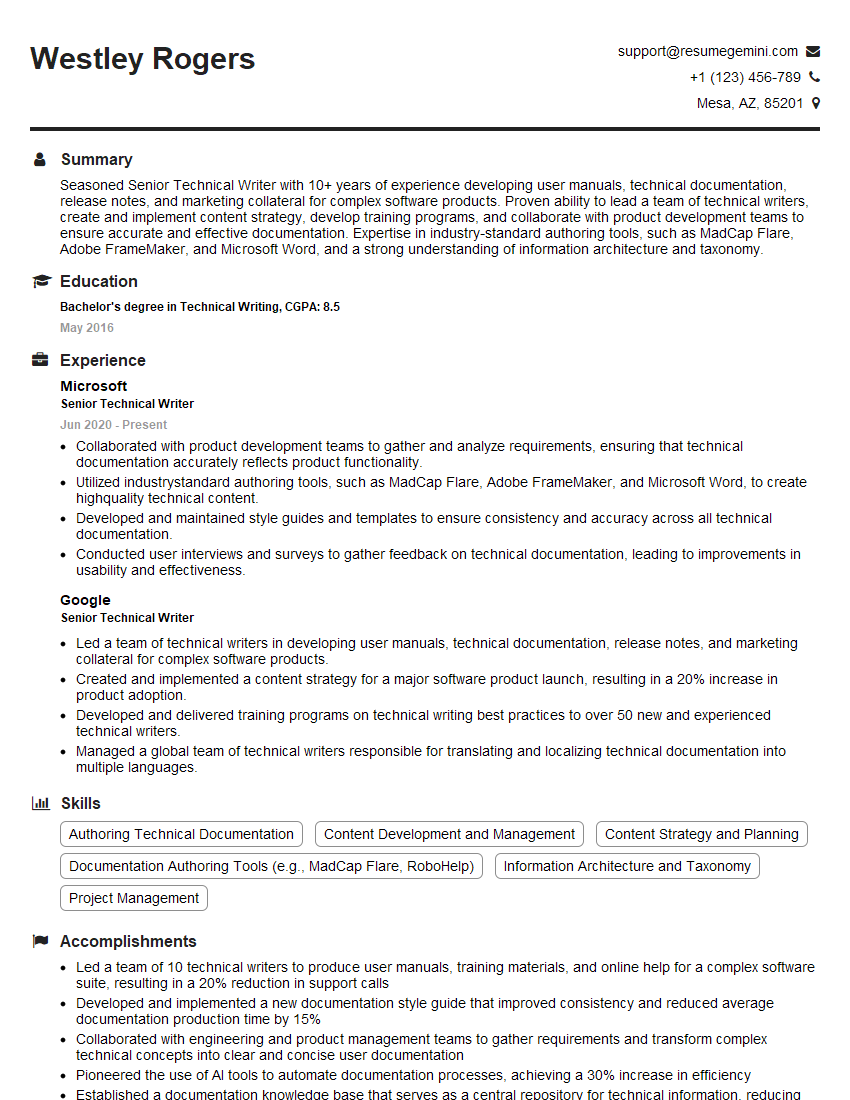Interviews are more than just a Q&A session—they’re a chance to prove your worth. This blog dives into essential Documentation Improvement interview questions and expert tips to help you align your answers with what hiring managers are looking for. Start preparing to shine!
Questions Asked in Documentation Improvement Interview
Q 1. Explain your experience with different documentation formats (e.g., user manuals, API docs, online help).
My experience spans a wide range of documentation formats, each tailored to its specific audience and purpose. For instance, I’ve crafted user manuals that guide end-users through software features, employing clear, concise language and incorporating screenshots or videos for visual learners. These often involve structuring information logically, using a combination of step-by-step instructions, FAQs, and troubleshooting sections.
API documentation, on the other hand, requires a different approach. Here, I’ve focused on precise descriptions of methods, parameters, return values, and error codes, often using code examples in various programming languages (e.g., curl, Python, Java). I’ve leveraged tools like Swagger and OpenAPI to generate interactive API documentation, enhancing developer experience. Finally, online help systems often demand a search-friendly structure, employing keywords and context-sensitive help features to provide quick access to information. I’ve worked on integrating such systems with various helpdesk platforms.
In each case, the key is adapting the style, structure, and level of technical detail to suit the target audience. For example, a user manual might use layman’s terms, while API documentation needs to be meticulously precise for developers.
Q 2. Describe your process for gathering information for documentation projects.
My information gathering process is iterative and collaborative. It begins with a thorough understanding of the project’s goals and target audience. Then, I employ a multi-pronged approach:
- Interviews: I conduct interviews with subject matter experts (SMEs), developers, product managers, and even potential users to gather information directly from the source. This helps to identify key features, potential challenges, and user needs.
- Document Review: I review existing documentation, code comments, design documents, and other relevant materials to compile a comprehensive picture of the product or service.
- Hands-on Exploration: I personally use the product or service to understand its functionality firsthand. This helps me identify areas that require clarification or improvement in the documentation.
- User Feedback: I actively solicit feedback from users through surveys, beta testing, and user forums to identify areas where the documentation is unclear, incomplete, or inaccurate. This feedback loop is crucial for continuous improvement.
This combined approach ensures that the documentation accurately reflects the product, caters to the users’ needs, and addresses potential challenges proactively.
Q 3. How do you ensure consistency and accuracy in your documentation?
Consistency and accuracy are paramount in technical documentation. To achieve this, I use a combination of strategies:
- Style Guides: I develop and strictly adhere to style guides that define writing style, terminology, formatting, and visual elements. This ensures a unified voice and appearance across the documentation.
- Templates: I utilize consistent templates for various document types (e.g., API descriptions, user guides). Templates ensure consistency in structure and formatting.
- Version Control: Using tools like Git, changes are tracked, reviewed, and merged seamlessly, reducing the risk of inconsistencies. This also allows for easy rollback if needed.
- Review and Editing Processes: Multiple levels of review, including technical and editorial reviews, help to identify and correct errors and inconsistencies before publication. This collaborative process involves SMEs and other stakeholders.
- Automated Checks: I employ tools that perform automated checks for style, grammar, and spelling to catch errors early in the process.
By combining these methods, I minimize errors and ensure that the documentation is both accurate and consistent, building trust with the user.
Q 4. What tools and technologies are you proficient in for creating and managing documentation?
My toolset includes a variety of software for creating and managing documentation. I’m proficient in:
- Markdown editors: Such as Typora and Visual Studio Code with Markdown extensions, for writing and formatting content efficiently. Markdown’s simplicity allows for easy collaboration and version control.
- Documentation generators: Like Sphinx (for Python projects), JSDoc (for JavaScript), and Swagger/OpenAPI for API specifications, to automate the generation of documentation from code comments or specifications.
- Static site generators: Such as Jekyll and Hugo, to build and deploy documentation websites easily. These streamline the publishing process and enable easier updates.
- Version control systems: Primarily Git, for collaborative editing, version history management, and branching strategies. Git helps ensure consistent and manageable changes.
- Collaboration platforms: Such as Confluence and Google Docs, for sharing drafts, tracking changes, and facilitating feedback from stakeholders.
My selection of tools is driven by the specific project requirements and the need for efficiency and collaboration.
Q 5. How do you handle conflicting priorities or tight deadlines in a documentation project?
Handling conflicting priorities and tight deadlines requires a structured approach. I use a prioritization matrix, breaking down tasks into smaller, manageable units, focusing on the most crucial information first. This involves:
- Prioritization: Identifying the most critical sections of the documentation based on user needs and project goals. I often utilize a MoSCoW method (Must have, Should have, Could have, Won’t have) to classify features and ensure focus on essentials.
- Timeboxing: Allocating specific time slots for individual tasks to maintain focus and avoid scope creep. This helps manage time effectively.
- Agile methodologies: Applying agile principles, like iterative development and sprint planning, allows for flexibility and adaptation to changing priorities. Regular check-ins help identify and address potential delays.
- Communication: Open and transparent communication with stakeholders is essential to manage expectations and secure necessary resources.
Sometimes, making difficult choices and accepting that some features might need to be deferred is necessary for successful project completion within the given constraints. Prioritizing clarity and accuracy over completeness is often the best approach under pressure.
Q 6. Describe your experience with version control systems for documentation.
Version control systems, primarily Git, are fundamental to my documentation workflow. They enable collaborative editing, track changes over time, and allow for easy rollback to previous versions if errors are introduced. This is crucial for maintaining accuracy and consistency across multiple iterations of the documentation.
My typical workflow involves creating branches for new features or edits, committing changes with clear and concise commit messages, and then creating pull requests for review before merging into the main branch. This collaborative process ensures that multiple individuals can contribute to the documentation without causing conflicts and allows for thorough review before changes are published. Using a robust branching strategy, such as Gitflow, allows for managing multiple versions of the documentation simultaneously (e.g., for different releases of a product).
Q 7. How do you ensure your documentation is accessible to a diverse audience?
Ensuring accessibility for a diverse audience involves several key considerations:
- Plain Language: Using clear, concise language and avoiding technical jargon whenever possible, making the information easy to understand for a wider range of readers. I carefully consider the vocabulary and sentence structure employed.
- Multilingual Support: Offering documentation in multiple languages to reach a global audience. I work with translators to ensure accurate and culturally appropriate translations.
- Visual Aids: Using visuals like diagrams, screenshots, and videos to explain complex concepts or instructions, catering to different learning styles. Visuals can also aid accessibility for those with visual impairments if the alt-text is carefully considered.
- Accessibility Standards: Adhering to accessibility standards like WCAG (Web Content Accessibility Guidelines) for online documentation. This includes proper use of headings, alt text for images, and keyboard navigation for screen readers.
- Formatting and Layout: Using a clear and consistent layout with sufficient white space and appropriate font sizes to enhance readability and accessibility. This reduces visual clutter and improves comprehension.
By incorporating these practices, I strive to create documentation that is inclusive, understandable, and usable for everyone, regardless of their background, language, or abilities.
Q 8. How do you measure the effectiveness of your documentation?
Measuring documentation effectiveness isn’t about arbitrary metrics; it’s about understanding if it’s achieving its purpose: helping users succeed. I use a multi-faceted approach.
- User Feedback Surveys and Interviews: Directly asking users about their experience with the documentation – was it helpful, easy to understand, complete, etc. I use both short surveys integrated within the documentation itself and more in-depth interviews with a representative sample of users.
- Website Analytics: Tracking metrics like time spent on pages, bounce rate, and search terms reveals which sections are most (and least) effective. A high bounce rate on a key concept page, for example, signals a need for improvement.
- Support Ticket Analysis: A reduction in support tickets related to topics well-covered in the documentation shows its impact on reducing user frustration and reliance on support staff.
- Task Completion Rates: For documentation supporting a specific process or software feature, tracking the success rate of users completing related tasks offers a concrete measure of effectiveness.
- Qualitative Feedback: Looking at comments, reviews, or forum discussions where users interact with or mention the documentation provides valuable qualitative insight.
By combining these quantitative and qualitative methods, I get a holistic picture of documentation efficacy and areas for improvement.
Q 9. Explain your experience with single-sourcing and content reuse.
Single-sourcing and content reuse are crucial for maintaining consistency and efficiency in documentation. In my previous role, we migrated from a system of numerous separate documents to a single-source approach using a content management system (CMS).
This involved creating a structured content model, defining reusable components like paragraphs, tables, and code snippets, and using templates to assemble different document types (user guides, FAQs, release notes) from these building blocks.
For example, we had a section describing user authentication. Instead of rewriting this process across multiple manuals, we created a single, well-written section that was then included via templating in each relevant document. This ensured consistency and reduced the risk of discrepancies across different documents.
This transition significantly reduced maintenance overhead. When changes were needed, we only updated the source content once, and the updates propagated automatically to all related documents. The result was improved consistency, reduced errors, and a more efficient documentation workflow.
Q 10. How do you incorporate user feedback into your documentation process?
User feedback is the lifeblood of effective documentation. I actively solicit and incorporate user feedback through various channels:
- In-Documentation Feedback Forms: Simple forms embedded directly within the documentation allow users to provide immediate feedback on specific sections or topics.
- User Surveys: Regular surveys gather broader feedback on overall usability, clarity, completeness, and satisfaction.
- Usability Testing: Conducting formal usability testing sessions with representative users lets me observe their interactions with the documentation and identify pain points directly.
- Community Forums and Social Media: Monitoring online discussions where users mention the documentation can provide valuable insights and context for improvements.
- Support Ticket Analysis: Identifying patterns in support tickets often highlights areas where documentation needs improvement or clarification.
Once feedback is gathered, I analyze it to identify recurring themes and prioritize changes based on their impact and feasibility. I then update the documentation, ensuring transparency by sometimes acknowledging user contributions or feedback in the documentation itself. This closed-loop process keeps the documentation continually relevant and user-centric.
Q 11. Describe your experience working with a style guide or documentation standards.
Working within a defined style guide or documentation standards is essential for consistent, professional, and easily navigable documentation.
My experience includes adapting to and enforcing various style guides, from simple internal style sheets to more comprehensive standards based on industry best practices (e.g., DITA). These guides typically cover elements like:
- Voice and Tone: Establishing a consistent tone (formal, informal, friendly, technical) crucial for maintaining brand identity and reader engagement.
- Terminology and Glossary: Defining and consistently using specific terms across all documentation. A centralized glossary facilitates understanding and consistency.
- Structure and Formatting: Guidelines on headings, lists, tables, code formatting, and visual layout, contributing to a user-friendly and accessible experience.
- Graphics and Illustrations: Specifications for image resolution, captions, and style to ensure visual consistency and clarity.
I’ve also been involved in developing and revising style guides, working collaboratively with stakeholders to ensure the guidelines are practical, useful, and aligned with the overall communication strategy of the organization. Adherence to these standards ensures quality, consistency, and maintainability of the documentation over time.
Q 12. How do you prioritize documentation tasks in a large project?
Prioritizing documentation tasks in a large project requires a strategic approach. I typically use a combination of methods:
- Dependency Mapping: Identify which documentation pieces depend on others. For instance, a user guide might depend on API documentation being complete first. This creates a logical workflow.
- Risk Assessment: Evaluate the potential risks of delaying or neglecting certain documentation tasks. Documentation related to security or critical features, for example, might take priority.
- Value Prioritization: Assign a value to each task based on its importance to users. This could be determined through user feedback, business requirements, or impact analysis.
- MoSCoW Method: Categorize tasks as Must have, Should have, Could have, and Won’t have. This framework helps focus efforts on the most essential elements.
- Agile Techniques: Using sprint planning within an Agile framework allows for iterative development and prioritization of documentation tasks based on sprint goals.
Regularly reviewing and adapting this prioritization is essential to respond to changing project needs and feedback. Using project management tools helps to visualize the prioritized tasks and track progress effectively.
Q 13. What strategies do you use to improve the clarity and readability of your documentation?
Improving clarity and readability requires a focus on both content and presentation. Here are some strategies I employ:
- Audience Analysis: Understanding the technical proficiency and background of the target audience helps tailor the language and level of detail appropriately.
- Simple Language and Active Voice: Avoiding jargon, technical terms, or passive voice makes the documentation accessible and easy to understand.
- Clear Structure and Organization: Using headings, subheadings, bullet points, and numbered lists enhances readability and makes information easily scannable.
- Visual Aids: Incorporating diagrams, illustrations, screenshots, and videos effectively communicates complex ideas and enhances engagement.
- Concise and Focused Writing: Avoiding unnecessary words and getting straight to the point ensures that the documentation doesn’t overwhelm the reader.
- Proofreading and Editing: Thorough proofreading and editing are crucial for eliminating grammatical errors, typos, and inconsistencies.
- Usability Testing: Testing the documentation with real users helps identify areas where clarity and readability can be improved.
Employing these strategies improves documentation usability, reduces user confusion, and ultimately contributes to successful product adoption and user satisfaction. Think of it like telling a story; the goal is to guide the user smoothly to their desired outcome.
Q 14. Explain your experience with creating and maintaining a knowledge base.
Creating and maintaining a knowledge base requires a structured approach and careful consideration of user needs. My experience involves:
- Content Strategy: Defining the scope of the knowledge base, identifying key topics, and developing a consistent taxonomy or categorization system.
- Knowledge Base Software Selection: Choosing a platform that meets the needs of the organization and users, considering features like search functionality, content management capabilities, and user access controls.
- Content Creation and Curation: Developing high-quality, accurate, and easily accessible content, including FAQs, troubleshooting guides, tutorials, and how-to articles.
- Search Engine Optimization (SEO): Optimizing the knowledge base for search engines to ensure that users can easily find the information they need.
- Content Updates and Maintenance: Regularly reviewing and updating the content to ensure accuracy, relevance, and completeness. This involves addressing user feedback, updating content based on product changes, and removing outdated information.
- User Feedback and Analytics: Monitoring user interactions and feedback to identify areas for improvement in the knowledge base’s structure, content, and usability.
A well-maintained knowledge base acts as a central repository of information, reducing reliance on support staff, empowering users to solve their problems independently, and ultimately enhancing overall user experience.
Q 15. How do you handle technical jargon and make complex information easier to understand?
Simplifying complex technical information hinges on understanding your audience and translating jargon into plain language. I employ several strategies. First, I identify the core concepts and break them down into smaller, digestible chunks. Think of it like assembling a LEGO castle – the final product is complex, but each step is manageable. Second, I replace technical jargon with clear, everyday language. For instance, instead of saying “the application utilizes asynchronous processing,” I might say “the application performs multiple tasks simultaneously in the background.” Third, I utilize analogies and metaphors. Comparing a complex process to something familiar, such as a traffic flow or a recipe, makes it easier to grasp. Finally, I always prioritize visual aids – diagrams, flowcharts, and screenshots – to enhance understanding. For example, explaining network protocols with a visual representation of data packets traversing a network is far more effective than dense paragraphs of text.
Example: Instead of writing “The database schema requires normalization to eliminate data redundancy,” I would write something like: “To avoid repeating information and keep our data organized, we’ve structured the database in a way that avoids unnecessary duplication.”
Career Expert Tips:
- Ace those interviews! Prepare effectively by reviewing the Top 50 Most Common Interview Questions on ResumeGemini.
- Navigate your job search with confidence! Explore a wide range of Career Tips on ResumeGemini. Learn about common challenges and recommendations to overcome them.
- Craft the perfect resume! Master the Art of Resume Writing with ResumeGemini’s guide. Showcase your unique qualifications and achievements effectively.
- Don’t miss out on holiday savings! Build your dream resume with ResumeGemini’s ATS optimized templates.
Q 16. How do you stay current with best practices in technical writing and documentation?
Staying current in technical writing requires continuous learning. I actively participate in online communities such as the Society for Technical Communication (STC) and subscribe to relevant newsletters and blogs. Attending webinars and conferences, like those organized by STC or Write the Docs, is invaluable for networking and learning about the latest trends and best practices. I regularly review industry publications and books on technical writing, focusing on new tools, methodologies, and standards. Furthermore, I actively experiment with new documentation tools and authoring formats to stay ahead of the curve and adapt my skills to emerging technologies. This continuous process ensures my skills remain sharp and relevant to the industry’s evolving needs.
Q 17. Describe a time you had to improve existing documentation. What was your approach?
I once inherited a legacy documentation set for a complex software system. The documentation was outdated, inconsistent, and difficult to navigate. My approach was systematic: First, I conducted a thorough analysis, identifying areas needing improvement. This included evaluating the content’s accuracy, completeness, clarity, and consistency. I also surveyed users to gauge their experience with the existing documentation. Second, I created a detailed improvement plan, prioritizing critical updates and setting realistic timelines. Third, I used a collaborative approach, working closely with developers to ensure accuracy. Fourth, I implemented a new information architecture, improving navigation and searchability. I also adopted a consistent style guide and updated the visual design to enhance readability. Finally, I established a process for ongoing maintenance and updates, minimizing future issues. The result was a vastly improved documentation set that was well-organized, easily searchable, and user-friendly, ultimately leading to a significant decrease in user support tickets.
Q 18. What are some common challenges you face in documentation projects, and how do you overcome them?
Common challenges include managing competing priorities, balancing detail with brevity, and ensuring accuracy. Keeping documentation up-to-date amidst rapid software development cycles is also a major hurdle. I overcome these by prioritizing tasks based on impact and urgency using project management techniques like Agile methodologies. To balance detail and brevity, I write concisely, using clear and direct language, supported by visual aids where necessary. To ensure accuracy, I work closely with developers and subject matter experts throughout the documentation process. I use version control systems and collaborative authoring tools to efficiently manage updates and revisions. Automated testing of documentation is also implemented where possible. For example, ensuring links to internal documentation work is often a task that can be automated.
Q 19. How do you collaborate effectively with developers, engineers, and other stakeholders?
Effective collaboration is vital. I foster open communication through regular meetings, using tools like Slack or Microsoft Teams for quick questions. I actively solicit feedback from developers, engineers, and users, incorporating their input into the documentation. I use collaborative writing tools like Google Docs or Microsoft SharePoint to enable simultaneous editing and review. I also create clear communication channels and guidelines to ensure all stakeholders understand their roles and responsibilities, promoting transparency and efficient information flow. This approach ensures that everyone feels heard and that the documentation accurately reflects the product or system.
Q 20. What experience do you have with documentation automation tools?
I have extensive experience with various documentation automation tools. I’m proficient in using tools like MadCap Flare, DITA-XML based systems, and Markdown processors like Pandoc. I’m familiar with version control systems like Git and collaborative platforms such as GitHub and GitLab for managing documentation projects. My experience includes automating the build process for documentation, generating different output formats (PDF, HTML, etc.), and integrating documentation with CI/CD pipelines. For example, I’ve used MadCap Flare to create responsive documentation and integrated it with a content management system for streamlined publishing and updates.
Q 21. How do you ensure your documentation is up-to-date and relevant?
Keeping documentation current requires a proactive strategy. I embed updates into the development process, creating a feedback loop between developers and documentation writers. I use version control to track changes and ensure consistency. I implement a regular review schedule, incorporating feedback from users and stakeholders. Automated tools can monitor changes in the software code and flag areas needing documentation updates. For example, I utilize a system of versioned documentation paired with issue tracking in order to generate updates. This system ensures that when code is updated, the documentation also reflects those updates.
Q 22. What is your experience with different content management systems (CMS)?
My experience with Content Management Systems (CMS) spans several platforms, including WordPress, Drupal, and Adobe Experience Manager (AEM). I’m proficient in using these systems to create, manage, and publish documentation. For instance, I used WordPress to build a knowledge base for a client, leveraging its ease of use and plugin ecosystem for features like search and version control. With AEM, I’ve worked on larger-scale projects requiring robust content modeling and workflow management for complex technical documentation. My experience also includes working with simpler systems like Markdown-based static site generators, highlighting my adaptability to diverse technological environments. I understand the strengths and weaknesses of each system and choose the most appropriate one based on project scope, budget, and client needs.
Q 23. Explain your process for reviewing and editing documentation.
My documentation review and editing process is iterative and focuses on clarity, accuracy, and consistency. It involves several key stages:
- Initial Review: I start by thoroughly reading the document, focusing on comprehension and identifying potential issues with clarity, accuracy, and consistency of terminology and style.
- Structural Analysis: I then analyze the document’s structure – is the information logically organized? Are headings and subheadings clear and effective? Does the flow of information make sense?
- Style and Tone Review: Next, I assess the writing style and tone to ensure it aligns with the target audience and brand voice. This includes checking for grammar, spelling, punctuation, and sentence structure.
- Fact-Checking and Verification: Crucially, I verify all factual information, checking technical details and ensuring accuracy. This often involves consulting other sources or subject matter experts.
- Usability Testing (where applicable): I employ usability testing techniques like user interviews or surveys to assess how easily the target audience can understand and use the documentation.
- Revision and Iteration: Finally, I make the necessary edits and revisions, iterating through the process as needed until the document meets the required quality standards.
Throughout this process, I maintain detailed comments and track changes using version control systems like Git, ensuring transparency and collaboration.
Q 24. How do you handle feedback from stakeholders that conflicts with your proposed approach?
Handling conflicting stakeholder feedback requires a collaborative and diplomatic approach. My strategy involves:
- Understanding the Concerns: I begin by carefully listening to and documenting all feedback, attempting to understand the rationale behind each point of view. It’s vital to understand the reasons for any objections.
- Finding Common Ground: I seek to identify any areas of agreement. Often, a compromise can be reached that satisfies the primary concerns of all stakeholders.
- Data-Driven Discussion: Where discrepancies persist, I provide data or evidence to support my proposed approach, explaining the benefits and potential drawbacks of different options. This might involve user research data, industry best practices, or usability testing results.
- Compromise and Negotiation: I engage in constructive dialogue to find a mutually acceptable solution. This may involve modifying my initial proposal to address valid concerns or explaining why certain changes are infeasible.
- Documentation and Transparency: All decisions and their rationale are clearly documented and communicated to stakeholders. This fosters transparency and accountability.
Ultimately, the goal is to arrive at a solution that balances competing priorities while upholding the quality and usability of the documentation.
Q 25. How do you ensure that your documentation meets the needs of its intended audience?
Understanding the target audience is paramount. I employ several methods to ensure the documentation meets their needs:
- Audience Analysis: I conduct thorough research to define the audience’s technical expertise, goals, and preferred learning styles. This might involve surveys, interviews, and analysis of existing documentation usage patterns.
- Persona Development: I create detailed user personas representing different segments of the target audience. This helps me tailor the content and language to specific user needs.
- Content Structure and Organization: I structure the documentation to facilitate efficient information retrieval. This includes clear navigation, search capabilities, and logical organization of information.
- Language and Tone: The language used is adjusted to match the audience’s technical proficiency. For example, technical documentation for developers would be different from user documentation for end-users.
- Usability Testing: I regularly test the documentation with representatives from the target audience to identify areas for improvement and ensure its effectiveness.
For example, when creating documentation for a complex software application, I might create separate manuals for developers, administrators, and end-users, each tailored to their specific needs and expertise levels.
Q 26. How would you approach improving the documentation for a legacy system?
Improving documentation for a legacy system is a significant undertaking, often requiring a phased approach:
- Assessment and Inventory: Begin by thoroughly assessing the existing documentation—its completeness, accuracy, consistency, and usability. Identify gaps and areas requiring immediate attention.
- Prioritization: Prioritize the most critical areas needing improvement based on user needs and business impact. Focus on the sections most frequently accessed or crucial for system operation.
- Content Migration and Modernization: Migrate the existing content to a modern CMS, if necessary. This provides improved workflow, collaborative capabilities, and better version control. Outdated or irrelevant information should be removed or updated.
- Rewriting and Restructuring: Rewrite unclear or outdated sections using modern terminology and clear, concise language. Restructure information to improve navigation and discoverability.
- Usability Testing: Conduct thorough usability testing throughout the process. This continuous feedback loop is critical to ensuring the improved documentation effectively meets user needs.
- Maintenance and Updates: Establish a clear process for maintaining and updating the documentation to reflect ongoing changes to the legacy system. This might include automated tools or workflow processes.
This systematic approach ensures a manageable and effective upgrade of the legacy documentation while minimizing disruption.
Q 27. Describe your experience with creating documentation for different types of software (e.g., web applications, mobile apps, embedded systems).
My experience encompasses documentation for various software types:
- Web Applications: I’ve created user guides, API documentation, and troubleshooting guides for web applications, focusing on user experience and clear navigation. I utilize tools like Swagger for API documentation and screen recordings for interactive tutorials.
- Mobile Apps: For mobile apps, my focus has been on creating concise, user-friendly guides, often incorporating screenshots and videos to demonstrate app functionality. I consider the limitations of mobile devices when designing and structuring the documentation.
- Embedded Systems: Documenting embedded systems requires a different approach. I’ve worked on creating technical specifications, hardware diagrams, and firmware documentation, ensuring accuracy and clarity for engineers and developers working with these systems. This often requires close collaboration with engineering teams.
Each type requires a tailored approach, considering the technical level of the audience, the complexity of the software, and the context in which it’s used.
Q 28. What methods do you use for testing and validating the usability of your documentation?
I employ several methods for testing and validating the usability of my documentation:
- Heuristic Evaluation: Experts review the documentation based on established usability principles, identifying potential issues with navigation, clarity, and overall user experience.
- Cognitive Walkthroughs: I simulate a user’s experience to identify potential points of confusion or difficulty in understanding the information provided.
- Usability Testing with Users: I conduct usability testing sessions with members of the target audience, observing their interactions with the documentation and gathering feedback. This typically involves recording user sessions and conducting post-session interviews.
- A/B Testing: For online documentation, A/B testing can be used to compare different versions of the content and identify which versions are most effective at achieving the desired outcomes.
- Surveys and Feedback Forms: Collecting user feedback through surveys and feedback forms provides valuable insights into areas for improvement. I incorporate these into my iterative review and improvement cycle.
These methods provide valuable feedback that’s directly used to refine the documentation, improving its overall quality and usability.
Key Topics to Learn for Documentation Improvement Interview
- Understanding User Needs: Analyzing target audience, their technical proficiency, and information needs to tailor documentation effectively.
- Information Architecture & Organization: Designing intuitive navigation structures, creating logical document flows, and implementing effective indexing and search capabilities.
- Content Strategy & Planning: Defining documentation goals, scope, and audience; developing content calendars and prioritizing tasks for efficient workflow.
- Writing Style & Clarity: Mastering concise, accurate, and engaging technical writing; employing clear language, avoiding jargon where possible, and using visuals effectively.
- Style Guides & Standards: Adhering to established style guides and maintaining consistency across documentation sets; understanding the importance of brand voice and tone.
- Usability Testing & Feedback: Implementing user testing methodologies to evaluate documentation effectiveness and incorporating feedback for continuous improvement.
- Version Control & Collaboration: Utilizing version control systems (e.g., Git) for collaborative document editing and tracking changes; managing different document versions effectively.
- Accessibility & Inclusivity: Ensuring documentation is accessible to users with disabilities, adhering to accessibility standards (e.g., WCAG), and creating inclusive content.
- Technical Writing Tools & Technologies: Familiarity with various technical writing tools (e.g., MadCap Flare, RoboHelp) and content management systems (CMS).
- Problem-Solving & Analytical Skills: Identifying areas for documentation improvement, proposing solutions, and demonstrating a proactive approach to resolving issues.
Next Steps
Mastering Documentation Improvement is crucial for career advancement in today’s tech-driven world. Strong documentation skills are highly valued, leading to increased responsibility and higher earning potential. To maximize your job prospects, create a compelling and ATS-friendly resume that showcases your expertise. ResumeGemini is a trusted resource to help you build a professional resume that highlights your achievements and skills effectively. Examples of resumes tailored to Documentation Improvement are available to help you get started.
Explore more articles
Users Rating of Our Blogs
Share Your Experience
We value your feedback! Please rate our content and share your thoughts (optional).
What Readers Say About Our Blog
Hello,
We found issues with your domain’s email setup that may be sending your messages to spam or blocking them completely. InboxShield Mini shows you how to fix it in minutes — no tech skills required.
Scan your domain now for details: https://inboxshield-mini.com/
— Adam @ InboxShield Mini
Reply STOP to unsubscribe
Hi, are you owner of interviewgemini.com? What if I told you I could help you find extra time in your schedule, reconnect with leads you didn’t even realize you missed, and bring in more “I want to work with you” conversations, without increasing your ad spend or hiring a full-time employee?
All with a flexible, budget-friendly service that could easily pay for itself. Sounds good?
Would it be nice to jump on a quick 10-minute call so I can show you exactly how we make this work?
Best,
Hapei
Marketing Director
Hey, I know you’re the owner of interviewgemini.com. I’ll be quick.
Fundraising for your business is tough and time-consuming. We make it easier by guaranteeing two private investor meetings each month, for six months. No demos, no pitch events – just direct introductions to active investors matched to your startup.
If youR17;re raising, this could help you build real momentum. Want me to send more info?
Hi, I represent an SEO company that specialises in getting you AI citations and higher rankings on Google. I’d like to offer you a 100% free SEO audit for your website. Would you be interested?
Hi, I represent an SEO company that specialises in getting you AI citations and higher rankings on Google. I’d like to offer you a 100% free SEO audit for your website. Would you be interested?
good



